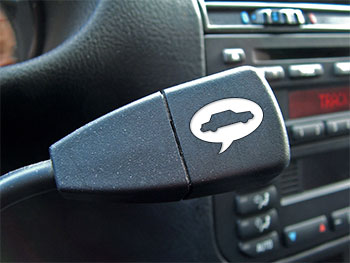A Talking Car?
Adding safety features and the ability to help you save fuel and time.
 Vehicle to vehicle communication or “ V2V” is the wireless exchange of data between vehicles ranging from cars, trucks, buses and trains. The data that is exchanged between the vehicles is basic safety information, such as speed, position, and location. The V2V communication senses threats and hazards with a 360-degree awareness of the position of another vehicle and the threat they may impose. V2V also calculates risk, issues driver advisories, and takes precautionary actions if needed to avoid a collision. These collisions include rear-end, lane change, and intersection crashes. Those would sure help during morning and afternoon work commutes! These safety features have been tested and proven in controlled and real-life tests.
Vehicle to vehicle communication or “ V2V” is the wireless exchange of data between vehicles ranging from cars, trucks, buses and trains. The data that is exchanged between the vehicles is basic safety information, such as speed, position, and location. The V2V communication senses threats and hazards with a 360-degree awareness of the position of another vehicle and the threat they may impose. V2V also calculates risk, issues driver advisories, and takes precautionary actions if needed to avoid a collision. These collisions include rear-end, lane change, and intersection crashes. Those would sure help during morning and afternoon work commutes! These safety features have been tested and proven in controlled and real-life tests.
In addition, to providing these safety features, V2V communication technologies could also help drivers conserve fuel and save time.
What this technology offers the driver is the awareness of their surroundings. An example of this can be if someone wants to pass on a two- lane road or if they wanted to make a left turn with oncoming traffic. The V2V can detect a threat from hundreds of yards away, avoiding a potential accident.
In August of 2012, The U.S. Department of Transportation, DOT, launched a “Model Deployment,” where 3,000 vehicles were sent out in a road test. This was testing the operability of vehicle to vehicle communication technology and how it was supported in different vehicles, in terms of different makes and different manufacturers. This test was conducted in a real-environment, in an attempt to yield the most accurate results. The results of the clinic showed high favorability and acceptance ratings and participants added that they would like the V2V option to be added to their own personal vehicle.
Secretary of V2V communication, Anthony Foxx stated, “Vehicle-to-vehicle technology represents the next generation of auto safety improvements, building on the life-saving achievements we’ve already seen with safety belts and air bags,” Foxx said. “By helping drivers avoid crashes, this technology will play a key role in improving the way people get where they need to go while ensuring that the U.S. remains the leader in the global automotive industry.”
The vision for the V2V technology is that each vehicle on the road will be able to communicate with each other and that this set of data will lead to an increase in the safety of drivers and vehicles alike, and a decrease in the number of car accidents.
 The National Highway Traffic Safety Administration will propose a proposition in the near future that in coming years, new vehicles will be equipped with this technology.
The National Highway Traffic Safety Administration will propose a proposition in the near future that in coming years, new vehicles will be equipped with this technology.
About the author:
Dan Deary is president of Capitol Collision Repair, one of the largest, independent body shops in Phoenix, now in their 26th year in business.
Car Stolen or Damaged? Give us a call to make an appointment 602-253-1630, or Request a FREE estimate.



